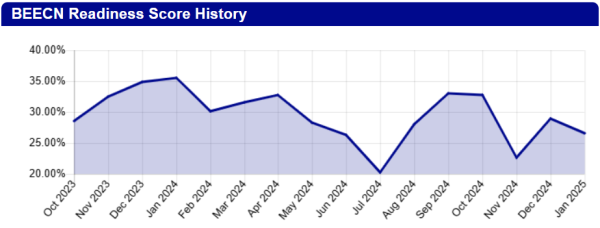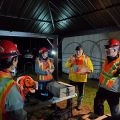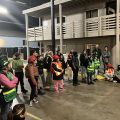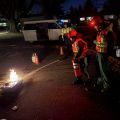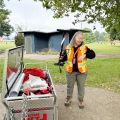Portland Preparedness Data Almanac: Difference between revisions
mNo edit summary |
|||
| (5 intermediate revisions by the same user not shown) | |||
| Line 6: | Line 6: | ||
<br /> | <br /> | ||
<div class="noautonum"> | <div class="noautonum"> | ||
__NOTOC__ | |||
</div> | </div> | ||
<br /> | <br /> | ||
| Line 145: | Line 145: | ||
|Programming | |Programming | ||
|Participation from Multnomah County, IRCO, and Lloyd EcoDistrict. | |Participation from Multnomah County, IRCO, and Lloyd EcoDistrict. | ||
|- | |||
|2025.02.24 | |||
|Response to multiple power lines down | |||
|Deployment | |||
|13 NET volunteers deployed. | |||
|- | |- | ||
|2025.02.21 | |2025.02.21 | ||
| Line 178: | Line 183: | ||
!CBO | !CBO | ||
!Description/Notes | !Description/Notes | ||
|- | |- | ||
| | | | ||
| Line 318: | Line 291: | ||
|'''2025 Start''' | |'''2025 Start''' | ||
|''January 1, 2025'' | |''January 1, 2025'' | ||
'''26.56%''' | |||
|- | |- | ||
| Line 385: | Line 359: | ||
|style="background-color: #993f90; border-left: 3px solid black;"|[[File:TMrain.png|center|50x50px]] | |style="background-color: #993f90; border-left: 3px solid black;"|[[File:TMrain.png|center|50x50px]] | ||
|style="background-color: #993f90; color: white; text-align: center" |<big>'''District 1'''</big> | |style="background-color: #993f90; color: white; text-align: center" |<big>'''District 1'''</big> | ||
|style="background-color: #cc9fc8; border-right: 3px solid black; text-align: center" | | |style="background-color: #cc9fc8; border-right: 3px solid black; text-align: center" |''148,117'' | ||
|style="background-color: #e6cfe3; text-align: center"| | |style="background-color: #e6cfe3; text-align: center"| | ||
|style="background-color: #e6cfe3; text-align: center"| | |style="background-color: #e6cfe3; text-align: center"| | ||
| Line 404: | Line 378: | ||
|style="background-color:#e5412c; border-left: 3px solid black;"|[[File:TMsalmon.png|center|50x50px]] | |style="background-color:#e5412c; border-left: 3px solid black;"|[[File:TMsalmon.png|center|50x50px]] | ||
|style="background-color:#e5412c; color:white; text-align: center"|<big>'''District 2'''</big> | |style="background-color:#e5412c; color:white; text-align: center"|<big>'''District 2'''</big> | ||
|style="background-color:#f2a096; border-right: 3px solid black; text-align: center"| | |style="background-color:#f2a096; border-right: 3px solid black; text-align: center"|''143,013'' | ||
|style="background-color:#f9d0ca; text-align: center"| | |style="background-color:#f9d0ca; text-align: center"| | ||
|style="background-color:#f9d0ca; text-align: center"| | |style="background-color:#f9d0ca; text-align: center"| | ||
| Line 423: | Line 397: | ||
|style="background-color: #30b457; border-left: 3px solid black;"|[[File:TMleaf.png|center|50x50px]] | |style="background-color: #30b457; border-left: 3px solid black;"|[[File:TMleaf.png|center|50x50px]] | ||
|style="background-color: #30b457; color: white; text-align: center"|<big>'''District 3'''</big> | |style="background-color: #30b457; color: white; text-align: center"|<big>'''District 3'''</big> | ||
|style="background-color: #98daab; border-right: 3px solid black; text-align: center"| | |style="background-color: #98daab; border-right: 3px solid black; text-align: center"|''153,705'' | ||
|style="background-color: #cbecd5; text-align: center"| | |style="background-color: #cbecd5; text-align: center"| | ||
|style="background-color: #cbecd5; text-align: center"| | |style="background-color: #cbecd5; text-align: center"| | ||
| Line 442: | Line 416: | ||
|style="background-color: #ffe01a; border-left: 3px solid black;"|[[File:TMrose.png|center|50x50px]] | |style="background-color: #ffe01a; border-left: 3px solid black;"|[[File:TMrose.png|center|50x50px]] | ||
|style="background-color: #ffe01a; text-align: center"|<big>'''District 4'''</big> | |style="background-color: #ffe01a; text-align: center"|<big>'''District 4'''</big> | ||
|style="background-color: #fff08d; border-right: 3px solid black; text-align: center"| | |style="background-color: #fff08d; border-right: 3px solid black; text-align: center"|''139,967'' | ||
|style="background-color: #fff7c6; text-align: center"| | |style="background-color: #fff7c6; text-align: center"| | ||
|style="background-color: #fff7c6; text-align: center"| | |style="background-color: #fff7c6; text-align: center"| | ||
| Line 458: | Line 432: | ||
|style="background-color: #fff08d; border-right: 3px solid black; text-align: center"| | |style="background-color: #fff08d; border-right: 3px solid black; text-align: center"| | ||
|style="background-color: #fff08d; border-right: 3px solid black; text-align: center"| | |style="background-color: #fff08d; border-right: 3px solid black; text-align: center"| | ||
|- | |||
|style="background-color: white; border-left: 3px solid black;"| | |||
|style="background-color: white; text-align: center"|'''<big>City Totals</big>''' | |||
|style="background-color: white; border-right: 3px solid black; text-align: center"|''584,802'' | |||
|style="background-color: white; text-align: center"| | |||
|style="background-color: white; text-align: center"| | |||
|style="background-color: white; text-align: center"| | |||
|style="background-color: white; border-right: 3px solid black; text-align: center"| | |||
|style="background-color: white; text-align: center"| | |||
|style="background-color: white; text-align: center"| | |||
|style="background-color: white; text-align: center"| | |||
|style="background-color: white; text-align: center"| | |||
|style="background-color: white; border-right: 3px solid black; text-align: center"| | |||
|style="background-color: white; text-align: center"| | |||
|style="background-color: white; text-align: center"| | |||
|style="background-color: white; text-align: center"| | |||
|style="background-color: white; text-align: center"| | |||
|style="background-color: white; border-right: 3px solid black; text-align: center"| | |||
|style="background-color: white; border-right: 3px solid black; text-align: center"| | |||
|} | |} | ||
| Line 1,054: | Line 1,047: | ||
=== 2025 Photo Gallery === | === 2025 Photo Gallery === | ||
<gallery> | <gallery> | ||
File: | File:2025.02.03.Woodstock NET.Westervelt.jpg|''Woodstock NETs at a team exercise. February 3, 2025.'' | ||
File:2025.03.01.Unidos BNT.Lozano (1).jpg|''Members of the Spanish-speaking UNIDOS team graduating from Basic NET. March 1, 2025.'' | |||
File:2025.03.23.HAZMAT (1).jpg|''Volunteers get fit tested for respirators during a HAZMAT awareness training. March 23, 2025.'' | |||
</gallery> | </gallery> | ||
</div> | </div> | ||
Revision as of 21:12, 30 March 2025
This data almanac is established to make available and accessible all salient Community Preparedness data collected by PBEM, sectioned into calendar years. PBEM does not make raw data downloadable because raw data includes Personally Identifiable Information (PII). However, where possible, PBEM breaks datasets into Portland Districts and neighborhoods to allow community leaders in those areas to make informed and data-driven decisions about emergency planning and disaster response strategies.
Important note: The data in this almanac is presented by calendar year, not the City's fiscal year (which runs from July 1 to June 30).
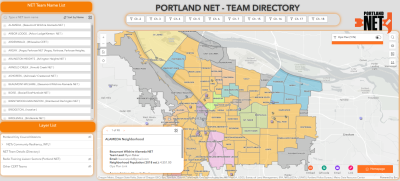
The almanac is a data storehouse for point in time data. The almanac does not include year to year comparisons or dynamic data, which may be found on the dashboards or maps below:
| Dashboard or Map |
|---|
| Portland NET Team Directory |
| BEECN Status Dashboard |
| Community Preparedness Budget Dashboard (presented by fiscal year, not calendar year) |
| PBEM Annual Volunteer Customer Service Survey Results |
| PBEM Community Outreach Tracking |
2025 PBEM Community Preparedness Program Data
2024 PBEM Community Preparedness Program Data
2023 PBEM Community Preparedness Program Data
How to Read the Data
This section guides readers on how to read and interpret the numbers that are not straightforward.
Logged %
Indicates the percentage of volunteers in the subject dataset that logged any hours at all (x > 0).
Pareto Numbers
Pareto Numbers are based on the Pareto Principle; the notion that for many outcomes, roughly 80% of consequences come from 20% of causes. For volunteer purposes, it is an index of volunteer activity. In strict mathematical terms, the Pareto Number indicates what percentage of active volunteers are logging 80% of the volunteer hours. If your NET community is a beehive, the Pareto Number answers: how loudly is that beehive buzzing?
The number indexes volunteer community activity in the respect that a low number would indicate very few active volunteers are actually engaged with programming. This would imply several prospective problems in that volunteer community, not the least of which include:
- Low volunteer activity;
- A small "hard core" of volunteers burning themselves out carrying the activity and volunteer labor of the other volunteers;
- A volunteer roster populated with inactive volunteers;
- A volunteer community where few of the volunteers know each other or regularly work together (particularly troublesome for disaster response volunteers).
Example: A Tale of Two Teams
Let's say there are two teams: Team 1 and Team 2. Each has ten volunteers. In a year, Team 1 logged 105 hours and Team 2 logged 100 hours. On the face of it, those numbers might suggest Team 1 was slightly more active than Team 2 in that year. But if we pull the hours of each individual team member, the picture looks like this:
| Team 1 | Team 2 | ||
|---|---|---|---|
| Volunteer | Hours | Volunteer | Hours |
| Vol. 1a | 85 | Vol. 2a | 20 |
| Vol. 1b | 6 | Vol. 2b | 17 |
| Vol. 1c | 5 | Vol. 2c | 15 |
| Vol. 1d | 3 | Vol. 2d | 15 |
| Vol. 1e | 3 | Vol. 2e | 12 |
| Vol. 1f | 0 | Vol. 2f | 11 |
| Vol. 1g | 0 | Vol. 2g | 7 |
| Vol. 1h | 0 | Vol. 2h | 3 |
| Vol. 1i | 0 | Vol. 2i | 0 |
| Vol. 1j | 0 | Vol. 2j | 0 |
80% of each team's hours is 84 and 80, respectively. On Team 1, one volunteer accomplished that portion. On Team 2, five volunteers made up 80% of the hours. So in this example, Team 1 has a Pareto score of 10% and Team 2 has 50%. Even though Team 1 logged more hours, Team 2 is distributing more of the weight of the work amongst themselves. This could mean that Team 2 is more resilient to volunteer burnout and has denser collaborative relationships.
This is not to denigrate the effort of "super volunteer" on Team 1 (who is also probably the Team Leader). We love super volunteers and appreciate their work! But if we need to evaluate the health of a team, we would encourage that volunteer to ask their teammates for help, or plan with PBEM how to get those volunteers more involved. A small number of volunteers should not be asked to carry the resilience effort of a whole neighborhood; that is simply too much. There are also five volunteers on Team 1 who logged zero hours. The Team Leader may want to ask PBEM if those volunteers are still active in the program.
Yearlong vs. Quarterly Pareto Numbers
This Wiki article references both annual ("Yearlong") and quarterly Pareto Numbers for Portland Districts. However, only the annual number is really important; quarterly figures are more of a curiosity and do not really say much about overall team activity.
MSC: Minimum Service Contribution
This metric indicates what percentage of active volunteers in the dataset made their Minimum Service Contribution of twelve logged hours in a year.
Notes and References
- ↑ Estimating team hours is tricky, because team members do not spend all their hours on community preparedness programming. The team will get deployed during incidents or work on other bureau projects. Also, some weeks, team members may volunteer time over 40 hours.
- ↑ All hour totals represent the number of hours logged by volunteers. Actual volunteer hours are underreported.
- ↑ Deployment hours represent hours spent responding to an emergency incident. Service hours represent hours that directly improve programming, such as through instruction, event planning, filming training videos, writing articles, and so on.
- ↑ Hours spent either in Basic NET Training, or hours refreshing basic volunteer skills (e.g. an Active NET volunteer re-taking Basic NET Training).
- ↑ Hours in advanced training courses or in response exercises.
- ↑ Any hours related to BEECN or amateur radio activities by PBEM volunteers.
- ↑ Community engagement hours include NET team meetings, community presentations, NET Team Leader responsibilities, tabling at events, etc.
- ↑ The "Pareto number" (based on the Pareto Principle) is an index of volunteer activity. It is one method for measuring how active PBEM volunteers are. The number is the percentage of active PBEM volunteers who contributed 80% of the reported volunteer hours. A higher number is a higher representation of activity (so: the higher the number, the better). A program with consistently low Pareto numbers is probably not sustainable, as that would indicate a very small number of volunteers doing almost all of the work.
- ↑ Minimum Service Contribution.
- ↑ Estimating team hours is tricky, because team members do not spend all their hours on community preparedness programming. The team will get deployed during incidents or work on other bureau projects. Also, some weeks, team members may volunteer time over 40 hours.
- ↑ All hour totals represent the number of hours logged by volunteers. Actual volunteer hours are underreported.
- ↑ Deployment hours represent hours spent responding to an emergency incident. Service hours represent hours that directly improve programming, such as through instruction, event planning, filming training videos, writing articles, and so on.
- ↑ Hours spent either in Basic NET Training, or hours refreshing basic volunteer skills (e.g. an Active NET volunteer re-taking Basic NET Training).
- ↑ Hours in advanced training courses or in response exercises.
- ↑ Any hours related to BEECN or amateur radio activities by PBEM volunteers.
- ↑ Community engagement hours include NET team meetings, community presentations, NET Team Leader responsibilities, tabling at events, etc.
- ↑ The "Pareto number" (based on the Pareto Principle) is an index of volunteer activity. It is one method for measuring how active PBEM volunteers are. The number is the percentage of active PBEM volunteers who contributed 80% of the reported volunteer hours. A higher number is a higher representation of activity (so: the higher the number, the better). A program with consistently low Pareto numbers is probably not sustainable, as that would indicate a very small number of volunteers doing almost all of the work.
- ↑ Minimum Service Contribution.
- ↑ From: https://www.portland.gov/civic/documents/district-1-profile-2023/download
- ↑ From: https://www.portland.gov/civic/documents/district-2-profile-2023/download
- ↑ From: https://www.portland.gov/civic/documents/district-3-profile-2023/download
- ↑ From: https://www.portland.gov/civic/documents/district-4-profile-2023/download
- ↑ Estimating team hours is tricky, because team members do not spend all their hours on community preparedness programming. The team will get deployed during incidents or work on other bureau projects. Also, some weeks, team members may volunteer time over 40 hours.
- ↑ All hour totals represent the number of hours logged by volunteers. Actual volunteer hours are underreported.
- ↑ Deployment hours represent hours spent responding to an emergency incident. Service hours represent hours that directly improve programming, such as through instruction, event planning, filming training videos, writing articles, and so on.
- ↑ Hours spent either in Basic NET Training, or hours refreshing basic volunteer skills (e.g. an Active NET volunteer re-taking Basic NET Training).
- ↑ Hours in advanced training courses or in response exercises.
- ↑ Any hours related to BEECN or amateur radio activities by PBEM volunteers.
- ↑ Community engagement hours include NET team meetings, community presentations, NET Team Leader responsibilities, tabling at events, etc.
- ↑ The "Pareto number" (based on the Pareto Principle) is an index of volunteer activity. It is one method for measuring how active PBEM volunteers are. The number is the percentage of active PBEM volunteers who contributed 80% of the reported volunteer hours. A higher number is a higher representation of activity (so: the higher the number, the better). A program with consistently low Pareto numbers is probably not sustainable, as that would indicate a very small number of volunteers doing almost all of the work.
- ↑ Minimum Service Contribution.










